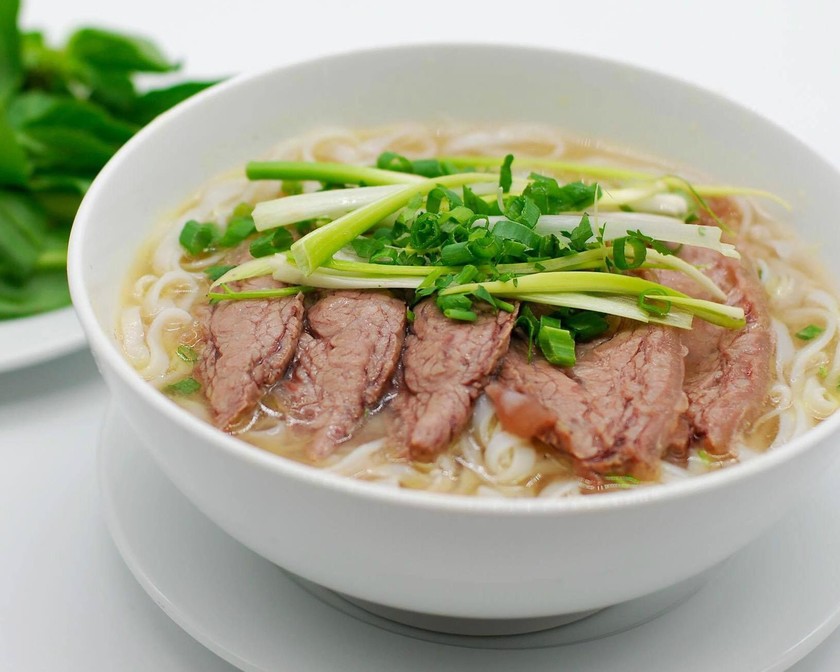Pho, pronounced “fuh,” is an iconic Vietnamese dish that is cherished both within Vietnam and around the world. This steaming bowl of aromatic noodle soup represents the heart and soul of Vietnamese cuisine. At its core, Pho is a harmonious blend of three primary elements: a rich, savory broth, slender rice noodles, and an assortment of tender meats or vegetables. The broth, often simmered for hours or even days, is the crown jewel of Pho. It’s typically made by infusing beef bones, charred onions, ginger, and an array of spices like star anise and cinnamon. This slow-cooking process imparts a deep, complex flavor to the broth, creating a tantalizing base for the rest of the dish.
The choice of meat for your Pho can vary, but it most commonly includes thinly sliced beef, often called “Pho Tai,” which cooks gently in the hot broth, remaining tender and flavorful. The other popular option is “Pho Ga,” which features chicken instead of beef. For the vegetarians, there’s “Pho Chay” made with a variety of tofu and vegetables. Each variation offers a unique experience, but they all share the same delightful broth and delicate noodles.
The rice noodles in Pho are an essential element, providing a textural contrast to the savory broth and tender meat. These noodles are soft, flat, and slightly chewy, making them a perfect canvas for absorbing the flavors of the broth. When you order your bowl of Pho, you can choose between different noodle sizes, with “Pho Tai” featuring the thinner noodles, and “Pho Gan” having slightly thicker ones. The noodles are cooked separately and added to the hot broth just before serving.
Pho’s exquisite aroma and flavor profile are heightened by the garnishes and accompaniments. A typical bowl of Pho comes with a plate of fresh herbs, such as Thai basil, cilantro, mint, and bean sprouts, which add a burst of freshness and fragrance to each bite. Slices of lime or lemon are often provided to customize the level of tanginess to your liking. Another common addition is bird’s eye chili for those who prefer a spicy kick. Hoisin sauce and sriracha are also usually on the table, allowing you to personalize your Pho with sweetness and heat.
The origins of Pho can be traced back to the early 20th century in Northern Vietnam, primarily around Hanoi. While its exact history is still debated, many believe that Pho was influenced by Chinese and French culinary traditions. Regardless of its origins, Pho quickly became a national treasure and an integral part of Vietnamese culture. It was initially a street food, but it has since spread to restaurants and eateries worldwide, becoming a symbol of Vietnamese cuisine.
Pho is not merely a meal; it’s an experience that unites people, from bustling street vendors to families gathered around the dinner table. The process of savoring a bowl of Pho is a slow and thoughtful one. It begins with the first wafts of the fragrant broth, and as you spoon the soup to your lips, you’re greeted with the warmth of the broth and the harmony of flavors. The act of choosing your herbs and condiments and combining them with the noodles and broth is an art in itself, allowing you to tailor the taste to your preference.
Beyond the sensory pleasure, Pho embodies the Vietnamese spirit of resourcefulness and the ability to transform humble ingredients into a culinary masterpiece. It also symbolizes the country’s cultural diversity, reflecting the blend of regional flavors and influences that define Vietnam. Pho is more than just a dish; it’s a reflection of history, culture, and the enduring passion of the Vietnamese people for their food.
In conclusion, Pho is a symbol of Vietnam, a culinary masterpiece celebrated for its captivating flavors, regional diversity, and the deep cultural significance it holds. Its rich history and its ability to bring people together, both in Vietnam and across the globe, make it an essential part of Vietnamese cuisine and a must-try for anyone seeking an authentic taste of Vietnam’s vibrant food culture.


Comment (0)